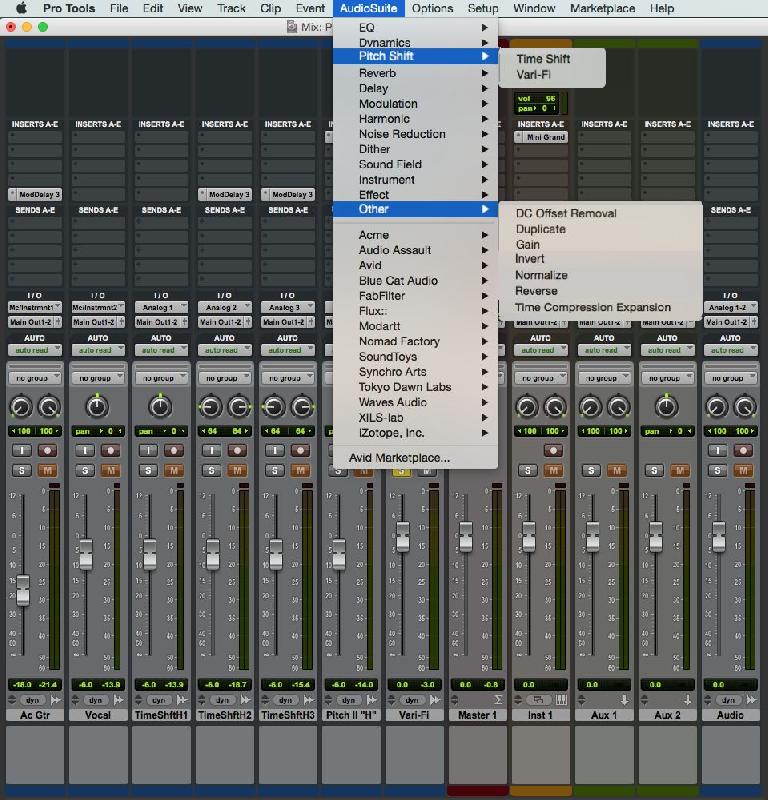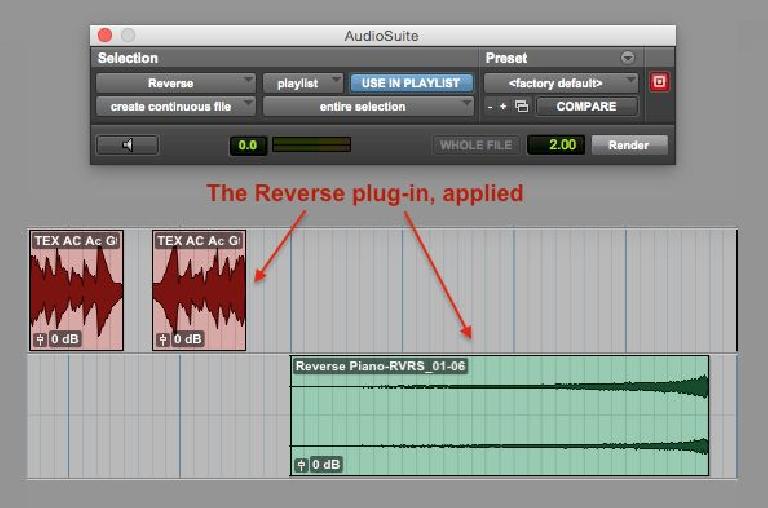While most of the plug-ins in the AudioSuite menu are offline (non-realtime) versions of real-time (channel strip insert) plug-ins, there are a number of included AudioSuite plug-ins that don’t have real-time (AAX) equivalents. If you don’t feel the need to go up to the AudioSuite menu much, you may not even be aware of them, but they do offer additional processing capabilities that could come in handy.
There are eight of these: Duplicate, DC-Offet Removal, Invert, Gain, Normalize, Reverse, Time Shift, and Vari-Fi. Most are simple utilities (sometimes with additional features added to equivalent real-time options), and a couple offer creative processing. I’ll briefly go through each of them...
Basic Utilities
In the AudioSuite menu’s “Other” sub-menu, you’ll find six utility plug-ins. Duplicate is a quick and easy way to make a copy of the audio in a selection, and drop the copy into the Clip List or Playlist. The new audiofile will be a duplicate of just the raw audio data, unaffected by any channel strip settings (volume/pan/automation) or plug-in processing (Bounce-to-Disk would include all those settings, unless you zero/bypass them).
- DC-Offset Removal is a problem solver, though for what’s probably an infrequent problem these days. DC-Offset is an audio artifact that’s often too small to be noticed when viewing the wave, but can cause clicks when you make an edit (even during silence). If that’s happening, and you suspect an Offset, this plug-in will scan the file and correct for it, making normal clean edits possible.
- Invert simply flips the polarity of the file (positive/negative). This can correct for a recording made with a mis-wired cable, or for acoustic issues (the bottom mic on a snare drum needs to be flipped to put that signal in “phase” with the top mic). This can also be done with the Phase button in the real-time Trim plug-in, but a permanent fix here frees up a plug-in slot.
- Gain is a fancier version of that same Trim plug-in. It includes an Analysis section, that lets you know what the resulting level will be after the Gain is changed (typically to avoid overloads). It can analyze the audio’s Peak level, or its Average level, in case you’re looking to match a selection (like a punch-in, perhaps) to the average level elsewhere in the track.

Fig 2 The Gain plug-in, with its Analyze feature.
- Normalize sets the level of the audio so its maximum peaks hit a certain level—usually just below the maximum digital level of 0 dBFS.

Fig 3 The Normalize plug-in.
This is typically used to take an audio recording (like a finished mix) that’s a little low in level, and quickly make it as loud as possible without overload. For a mix, a target level of around -0.3 to -1 dBFS is advised; for a track that will be further processed in a mix, a level no higher than -3 dBFS will allow more headroom. But keep in mind, normalizing is not the way to increase the level of a mix to those typical commercial (hot) levels—for that you’ll need a mastering brickwall limiter.
Effects and Such
Reverse does exactly what you’d expect—reverses the playback of the selected section of audio. You can get either that classic psychedelic reverse effect, or use it to create a build-up out of a note’s decay (Audio Example 1).
Audio Example 1—The Reverse plug-in applied to guitar and piano:
Under the Pitch Shift sub-menu, you’ll find the Time Shift plug-in (I know, it’s poorly named—it’s really does Time and Pitch shift effects). There are a lot more controls here than the other utility plugs, so no room for details—I’ll just do the big picture.

Fig 5 The Time Shift ( & pitch-shift) plug-in.
This plug-in offers an alternative to Elastic Audio’s realtime time-shifting capabilities. The algorithm here falls somewhere between EA’s real-time processing and its high-end X-Form offline option, which has the best audio quality Pro Tools offers (Time Shift supplanted the even older “Time Compression Expansion” AudioSuite plug-in, which is still available, in the “Other” sub-menu).
The Pitch-Shifting here offers something over & above the realtime Pitch II plug-in or EA’s Elastic Pitch feature. While Pitch II and Elastic Pitch provide easy real-time or per-clip options (respectively) for simple pitch shifts (small intonation corrections, ideally), their algorithms are less capable of handling larger shifts, making them less suitable for more demanding creative uses like generating harmonies and such. Time Shift’s pitch-shifting does a better job—with a more capable algorithm (and Formant adjustment, in Monophonic mode), shifts of several semitones, while not perfect-sounding, are much more useable (Audio Example 2).
Audio Example 2—A) A vocal line; B) Pitch-shifted in real time (via Pitch II, with no formant correction); Pitch-shifted with the Time Shift plugin (imperfect but better); D) A pitch-shifted harmony created with the Time Shift plug-in (in context):
Finally, Vari-Fi brings the classic turntable or tape-machine varispeed effect to the table (Audio Example 3). You can accomplish this with Elastic Audio as well, but I think it’s even quicker and easier to do here.

Figure 6 The Vari-Fi plug-in.
Audio Example 3—The VariFi plug-in’s classic turntable/tape machine slow-down & speed-up effects:
So those are Pro Tools’ AudioSuite-only plug-ins—from basic utility functions to the occasional creative effect, they’re a handy set of tools to add to the usual realtime processing.




 © 2024 Ask.Audio
A NonLinear Educating Company
© 2024 Ask.Audio
A NonLinear Educating Company
Discussion
Want to join the discussion?
Create an account or login to get started!